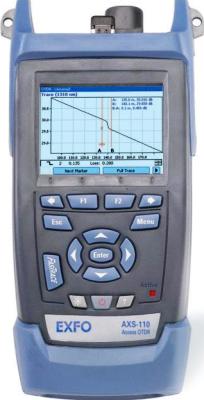
|
|
The EXFO AXS-110 All-Fiber OTDR helps you boost test productivity for inside-plant applications. Its exceptional 0.8 m event dead zone enables you to easily locate and characterize all events between the transmitter and the central office's fiber, access and FTTH network applications, where events are usually closely spaced. The AXS-110 combines singlemode and multimode functionalities, ideal for premises, private and enterprise network testing. Test multimode fiber within premises, or singlemode fiber between premises-all with a single OTDR unit-and maximize your return on investment. The AXS-110 lets you test through high-port-count splitters-even 1 x 64 splitters-perfect for passive optical network (PON) testing, delivering these key advantages: FTTx contractors and tier-2 certification of premises networks. Pass/fail features that comply with industry standards such as TIA 568c and IEEE 802.3ah. Power meter option, for crosschecking the total loss using the built-in OTDR laser in continuous source mode. Specifications. Wavelengths (nm) 850/1300/1310/1550. Dynamic range: (dB) 24/25/32/30 (850/1300/1310/1550). Pulse width (ns): 5, 10, 30, 100, 275, 1000 (Multimode), 5, 10, 30, 100, 275, 1000, 2500, 10 000 (Singlemode). Event dead zone (m): 0.8. Attenuation dead zone (m). 3.5/4.5/4/4.5. Linearity (dB/dB) ±0.03. Loss threshold (dB) 0.01. Loss resolution (dB) 0.01. Sampling resolution (m): 0.08 to 2.5 (Multimode), 0.08 to 5.0 (Singlemode). Sampling points Up to 64 000. Distance uncertainty (m): ±(0.75 + 0.0025 % x distance + sampling resolution). Distance range (km) 0.1 to 40 (Multimode), 0.65 to 260 (Singlemode). Typical real-time refresh (Hz): 4. Memory capacity: 500 traces. Measurement time: User-defined. Stable source output power (dBm): -1.5 (Multimode), -6.5 (Singlemode). Visual fault locator (optional): Laser, 650 nm ± 10 nm, CW typical Pout of 1.4 mW open beam. Power Meter (optional): Calibrated wavelengths (nm): 850, 1270, 1290, 1310, 1330, 1350, 1370, 1390, 1410, 1430, 1450, 1470, 1490, 1510, 1530, 1550, 1570, 1590, 1610, 1625. Power range (dBm): 26 to -64 (GeX 2 mm). Uncertainty: ±5 % ± 0.4 nW (up to 5 dBm).
|